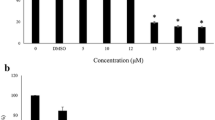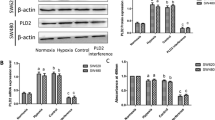Abstract
Activator protein-1 (AP-1) transcription factor plays a central role in hypoxia to modulate the expression of genes that decides the fate of the cell. The aim of the present study was to explore the role of AP-1 subunits in lung epithelial (A549) cells under hypoxia. Cell cycle studies by flow cytometry indicated that cell viability was unaffected by the initial hypoxia exposure (0.5% O2 at 37 °C) for 6 and 12 h. However, both transient cell cycle arrest and cell death was detected at 24 and 48 h. Flow cytometry and spectrofluorometry data confirmed the increase in ROS levels. Elevated ROS and calcium levels activated the stress-related MAPK signaling cascade. ERK and JNK were activated in early hypoxic exposure (within 6 h), whereas p38 were activated in 48 h of hypoxia. These subtypes further stimulated the subunits of AP-1 at different times of hypoxia exposure to orchestrate different genes responsible for cell proliferation (6 and 12 h) and apoptosis (24 and 48 h). Our results clearly depict the role of AP-1 heterodimer, i.e., p-c-jun/c-fos, p-c-jun/fosB, junD/c-fos, and junD/fosB in cell proliferation/survival by regulating the expression of Bcl-2 and cyclins (D1 and B1) at 6 h and 12 h of hypoxia, whereas junB/Fra-1 heterodimer have important role in apoptosis by regulating the expression of p53, Bax, and cyclin-dependent kinase inhibitors (p16, p21, p27) at 24 h and 48 h of hypoxia. Also, the cell survival signaling pathway NO-AKT interrupted at 24 h and 48 h of hypoxia indicating cell death. In conclusion, hypoxia for different time points activated different subunits of AP-1 that combined to form different heterodimers. These dimers regulated the expression of genes responsible for cell proliferation and apoptosis. Since, AP-1 plays a role in the decisive phenomenon of the cell to choose between proliferation and apoptosis; thus, its subunits or dimers could be a good therapeutic target for many diseases.










Similar content being viewed by others
Abbreviations
- p-c-jun:
-
Phosphorylated-c-jun
- MAPK:
-
Mitogen-activated protein kinase
- JNK:
-
Janus N-terminal kinase
- ERK:
-
Extracellular signal-regulated kinases
- AKT:
-
Protein kinase B
- ROS:
-
Reactive oxygen species
- NO:
-
Nitric oxide
References
Singh N, Dhalla AK, Seneviratne C, Singal PK (1995) Oxidative stress and heart failure. Mol Cell Biochem 147:77–81. doi:10.1007/BF00944786
Ramond A, Godin-Ribuot D, Ribuot C, Totoson P, Koritchneva I, Cachot S, Levy P, Joyeux-Faure M (2011) Oxidative stress mediates cardiac infarction aggravation induced by intermittent hypoxia. Fundam Clin Pharmacol 27:252–261. doi:10.1111/j.1472-8206.2011.01015
Dean OM, van den Buuse M, Berk M, Copolov DL, Mavros C, Bush AI (2011) N-acetyl cysteine restores brain glutathione loss in combined 2-cyclohexene-1-one and D-amphetamine-treated rats: relevance to schizophrenia and bipolar disorder. Neurosci Lett 499:149–153. doi:10.1016/j.neulet.2011.05.027
Halliwell Barry (2007) Oxidative stress and cancer: have we moved forward? Biochem J 401:1–11. doi:10.1042/BJ20061131
Clerici Christine, Planès Carole (2008) Gene regulation in the adaptive process to hypoxia in lung epithelial cells. Am J Physiol Lung Cell Mol Physiol 296:267–274. doi:10.1152/ajplung.90528.2008?
Son Yong, Cheong Yong-Kwan, Kim Nam-Ho, Chung Hun-Taeg, Kang Dae Gill, Pae Hyun-Ock (2011) Mitogen-activated protein kinases and reactive oxygen species: how can ROS activate MAPK pathways? J Sign Transduct. doi:10.1155/2011/7926395
Hwang O (2013) Role of oxidative stress in Parkinson’s disease. Exp Neurobiol 22:11–17. doi:10.5607/en.2013.22.1.11
Valko M, Leibfritz D, Moncol J, Cronin MTD, Mazur M, Telser J (2007) Free radicals and antioxidants in normal physiological functions and human disease. Int J Biochem Cell Biol 39:44–84. doi:10.1016/j.biocel.2006.07.001
Pohanka M (2013) Alzheimer´s disease and oxidative stress: a review. Curr Med Chem 21:356–364. doi:10.2174/09298673113206660258
Bonomini F, Tengattini S, Fabiano A, Bianchi R, Rezzani R (2008) Atherosclerosis and oxidative stress. Histol Histopathol 23:381–390
Amer J, Ghoti H, Rachmilewitz E, Koren A, Levin C, Fibach E (2006) Red blood cells, platelets and polymorphonuclear neutrophils of patients with sickle cell disease exhibit oxidative stress that can be ameliorated by antioxidants. Br J Hematol 132:108–113. doi:10.1111/j.1365-2141.2005.05834
Shaulian E, Karin M (2001) AP-1 in cell proliferation and survival. Oncogene 20:2390–2400
Li Y, Jenkins CW, Nichols MA, Xiong Y (1994) Cell cycle expression and p53 regulation of the cyclin-dependent kinase inhibitor p21. Oncogene 9:2261–2268
P53 (2016, May 9). In Wikipedia, the free encyclopedia. Retrieved 06:02, 13 May 2016, from https://en.wikipedia.org/w/index.php?title=P53&oldid=719463747
Sherr Charles J, Roberts James M (1999) CDK inhibitors: positive and negative regulators of G1-phase progression. Genes Dev 13:1501–1512
Stepniak Ewa, Ricci Romeo, Eferl Robert, Sumara Grzegorz, Sumara Izabela, Rath Martina, Hui Lijian, Wagner Erwin F (2006) c-Jun/AP-1 controls liver regeneration by repressing p53/p21 and p38 MAPK activity. Genes Dev 20:2306–2314
Solaini G, Baracca A, Lenaz G, Sgarbi G (2010) Hypoxia and mitochondrial oxidative metabolism. Biochim Biophys Acta 1797:1171–1177. doi:10.1016/j.bbabio.2010.02.011
Santos CXC, Anilkumar N, Zhang M, Brewer AC, Shah AM (2011) Redox signaling in cardiac myocytes. Free Radic Biol Med 50:777–793
Yin Jie (2013) Oxidative stress-mediated signaling pathways-A review. J Food Agric Environ 11:132–139
Schieber Michael, Chandel Navdeep S (2014) ROS function in redox signaling and review oxidative stress. Curr Biol. doi:10.1016/j.cub.2014.03.034
Sheng Morgan, Greenberg Michael E (1990) The regulation and function of c-fos and other immediate early genes in the nervous system 4:477–485
Hoffman GE, Smith MS, Verbalis JG (1993) c-Fos and related immediate early gene products as markers of activity in neuroendocrine systems. Front Neuroendocrinol 14:173–213
Bunn HF, Poyton RO (1996) Oxygen sensing and molecular adaptation to hypoxia. Physiol Rev 76:839–885
Semenza GL (2000) HIF-1: mediator of physiological and pathophysiological responses to hypoxia. J Appl Physiol 88:1474–1480
Kaminska Bozena, Pyrzynska Beata, Ciechomska Iwona, Wisniewska Marta (2000) Modulation of the composition of AP-1 complex and its impact on transcriptional activity. Acta Neurobiol 60:395–402
Ryseck Rolf-Peter, Bravo Rodrigo (1991) c-JUN, JUN B, and JUN D differ in their binding affinities to AP-1 and CRE consensus sequences: effect of FOS proteins. Oncogene 6:533–542
Angel P, Karin M (1991) The role of Jun, Fos and the AP-1 complex in cell-proliferation and transformation. Biochim Biophys Acta 1072:129–157
Van Dam H, Castellazzi M (2001) Distinct roles of Jun: Fos and Jun: ATF dimers in oncogenesis. Oncogene 20:2453–2464
LeBel CP, Ali SF, McKee M, Bondy SC (1990) Organometal-induced increases in oxygen reactive species: the potential of 2′,7′-dichlorofluorescin diacetate as an index of neurotoxic damage. Toxicol Appl Pharmacol 104:17–24
Bradford MM (1976) A rapid and sensitive for the quantitation of microgram quantities of protein utilizing the principle of protein-dye binding. Anal Biochem 72:248–254
Sen CK, Packer L (1996) Antioxidant and redox regulation of gene transcription. FASEB J 10:709–720
Thiel G, Lesch A, Keim A (2012) Transcriptional response to calcium-sensing receptor stimulation. Endocrinology 153:4716–4728
van Faassen Ernst E (2009) Nitrite as regulator of hypoxic signaling in mammalian physiology. Med Res Rev 29(5):683–741. doi:10.1002/med.20151
Premkumar DR, Adhikary G, Overholt JL, Simonson MS, Cherniack NS, Prabhakar NR (2000) Intracellular pathways linking hypoxia to activation of c-fos and AP-1. Adv Exp Med Biol 475:101–109
Jochum Wolfram (2001) AP-1 in mouse development and tumorigenesis. Oncogene 20:2401–2412
Shaulian Eitan, Karin Michael (2001) AP-1 as a regulator of cell life and death. Oncogene 20:2390–2400
Carmeliet Peter (1998) Role of HIF-1α in hypoxia-mediated apoptosis, cell proliferation and tumour angiogenesis. Nature 394:485–490. doi:10.1038/28867
Yu Z, Sato Seiichi, Trackman Philip C, Kirsch Kathrin H, Sonenshein Gail E (2012) Blimp1 activation by AP-1 in human lung cancer cells promotes a migratory phenotype and is inhibited by the lysyl oxidase propeptide. PLoS ONE. doi:10.1371/journal.pone.0033287
Ashida R, Tominaga K, Sasaki E (2005) AP-1 and colorectal cancer. Inflammopharmacology 13:113. doi:10.1163/156856005774423935
Zhao Chunyan, Qiao Yichun, Jonsson Philip, Wang Jian, Li Xu, Rouhi Pegah, Sinha Indranil, Cao Yihai, Williams Cecilia, Dahlman-Wright Karin (2014) Genome-wide profiling of AP-1 regulated transcription provides insights into the invasiveness of triple-negative breast cancer. Am Assoc Cancer Res. doi:10.1158/0008-5472.CAN-13-3396
Eckert RL, Adhikary G, Young CA, Jans R, Crish JF, Xu W, Rorke EA (2013) AP1 transcription factors in epidermal differentiation and skin cancer. J Skin Cancer, Article ID 537028. doi:10.1155/2013/537028
Acknowledgements
The authors acknowledge the Defence Research and Development Organization (DRDO), Director, Defence Institute of Physiology and Allied Sciences (DIPAS) and Council of Scientific and Industrial Research, India for providing necessary facilities and funding for this study.
Author information
Authors and Affiliations
Corresponding author
Ethics declarations
Conflict of interest
The author(s) declare that they have no conflict of interest.
Rights and permissions
About this article
Cite this article
Yadav, S., Kalra, N., Ganju, L. et al. Activator protein-1 (AP-1): a bridge between life and death in lung epithelial (A549) cells under hypoxia. Mol Cell Biochem 436, 99–110 (2017). https://doi.org/10.1007/s11010-017-3082-1
Received:
Accepted:
Published:
Issue Date:
DOI: https://doi.org/10.1007/s11010-017-3082-1




